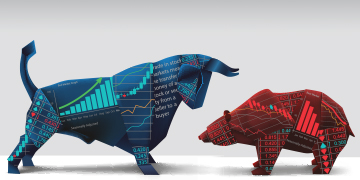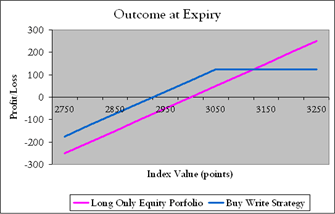Buy-Write strategy using index options

Your portfolio
You are a fund manager with a A$30 million portfolio benchmarked to the S&P™/ASX 200 Index. Assume the level of the index is 3000, and your portfolio matches the index.

Your market outlook
It is currently the beginning of July. You are basically neutral on the level of the index over the next quarter, thinking it will probably range 50 points either side (i.e. between 2950 and 3050).

Your objective
You wish to maintain your current market exposure, but would like to generate some extra returns above benchmark. Given you expect no market rise beyond 3050 you are prepared to cap your upside potential in exchange for adding some extra alpha.
The investment strategy
Execute a buy write strategy over the S&P™/ASX 200 Index portfolio using ASX index call options.
Implementation
Hold the long exposure in the index portfolio; sell S&P™/ASX200 index call options against the underlying equity position. The current index level is 3000, and the call options will be sold at 3050 strike.
The index option multiplier is $10, and the value of one call option contract is $30,000 ($10 x the index level). In this example a 3-month call option has a market value of 75 points (75 x $10), meaning the option premium generated by selling 1 contract is $750.
To sell index call options against a $30 million index portfolio would mean selling 1,000 call option contracts (portfolio value/contract value) generating $750,000 premium income.
Outcomes
The table below shows call option values if the index ranges between 2950 and 3100 points on expiry.
If the market stays neutral as expected: Because the option is sold at 3050, any index value at or below this level means the option expires worthless. The seller keeps the option premium and overall the buy write portfolio outperforms the benchmark1 .
If the market falls: Where the index level is below the current level of 3000 at expiry, then because the call option is sold at 3050, any index value at or below this level means the option expires worthless. The seller keeps the option premium and overall the buy write portfolio outperforms the benchmark . Of course the long stock portfolio suffers, but is cushioned by the premium earned on the option.
If the market rises above 3050: Because the call option is sold at 3050, any index value above this level means the option will expire with some intrinsic value. By implementing the buy write strategy your profit is capped at 3125 (3050 strike plus 75 point premium received). Any rise in the market beyond 3125 will mean you have foregone profit and the buy write strategy will underperform.
Note that in an absolute return sense, the upside market risk of the sold 3050 call is offset by your holding in the long stock portfolio. The seller keeps the option premium regardless of the outcome.
Above 3050 the call options will be assigned on expiry. ASX index options are European style so early assignment is not possible. Further, index options are cash settled, so the stock portfolio remains in tact.
| S&P™/ASX 200 Index (points) | Portfolio Change (points) | 3050 sold call option intrinsic value (points) | Call option Profit/Loss (points) | Buy write strategy at expiry: Profit/Loss (points) |
| 2950 | -50 | 0 | +75 (75-0) | +25 (-50+75) |
| 3000 | 0 | 0 | +75 (75-0) | +75 (0+75) |
| 3050 | +50 | 0 | +75 (75-0) | +125 (50+75) |
| 3100 | +100 | 50 | +25 (75-50) | +125 (100+25) |
| 3150 | +150 | 100 | -25 (75-100 | +125 (150-25) |
This example ignores transaction costs, commissions etc for simplicity.

Profit/loss outcomes of the Buy-Write strategy at expiry compared to benchmark (long only) portfolio
The upside of the buy write portfolio is capped (blue line), however it outperforms the long only portfolio (pink line) at every point below the cap.
*all else being equal.